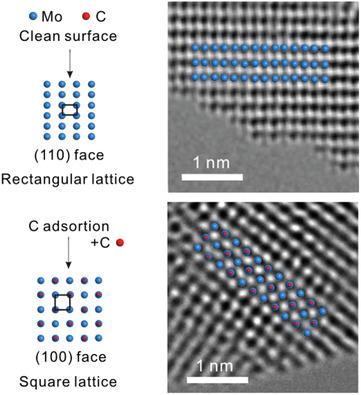Our official English website, www.x-mol.net, welcomes your
feedback! (Note: you will need to create a separate account there.)
Adsorption-Free Growth of Ultra-Thin Molybdenum Membranes with a Low-Symmetry Rectangular Lattice Structure.
Small ( IF 13.0 ) Pub Date : 2020-06-02 , DOI: 10.1002/smll.202001325 Jingjing Si 1 , Mengqi Zeng 1 , Huy Q Ta 2 , Shuting Zheng 1 , Jihai Liao 3 , Xiaobao Yang 3 , Mark H Rümmeli 2, 4, 5 , Lei Fu 1, 6
Small ( IF 13.0 ) Pub Date : 2020-06-02 , DOI: 10.1002/smll.202001325 Jingjing Si 1 , Mengqi Zeng 1 , Huy Q Ta 2 , Shuting Zheng 1 , Jihai Liao 3 , Xiaobao Yang 3 , Mark H Rümmeli 2, 4, 5 , Lei Fu 1, 6
Affiliation

|
Although low‐symmetry lattice structure of 2D transition metals is highly anticipated for both fundamental research and potentially distinctive application, it still has not been experimentally realized, which greatly hinders the exploration of the unique properties. Here, ultra‐thin body‐centered‐cubic (bcc) phase molybdenum (Mo) membranes are successfully synthesized with a low‐symmetry rectangular (110) crystal face via an adsorption‐free reaction. Through experimental and density functional theory studies, no foreign atoms being adsorbed is shown to be a key factor for the successful preparation of the bcc phase 2D transition metal with (110) faces. The realization of 2D Mo(110) with a low‐symmetric rectangular lattice structure extends the scope of 2D structures and is also beneficial for the exploration and development of low‐symmetry rectangular lattice‐structured materials with unique properties.
中文翻译:

具有低对称矩形晶格结构的超薄钼膜的无吸附生长。
尽管二维过渡金属的低对称晶格结构对于基础研究和潜在的独特应用都寄予了很高的期望,但仍未通过实验实现,这极大地阻碍了对独特性能的探索。在此,通过无吸附反应成功地合成了具有低对称矩形(110)晶面的超薄体心立方(bcc)相钼(Mo)膜。通过实验和密度泛函理论研究,没有杂质被吸附是成功制备具有(110)面的bcc相2D过渡金属的关键因素。
更新日期:2020-07-02
中文翻译:

具有低对称矩形晶格结构的超薄钼膜的无吸附生长。
尽管二维过渡金属的低对称晶格结构对于基础研究和潜在的独特应用都寄予了很高的期望,但仍未通过实验实现,这极大地阻碍了对独特性能的探索。在此,通过无吸附反应成功地合成了具有低对称矩形(110)晶面的超薄体心立方(bcc)相钼(Mo)膜。通过实验和密度泛函理论研究,没有杂质被吸附是成功制备具有(110)面的bcc相2D过渡金属的关键因素。











































 京公网安备 11010802027423号
京公网安备 11010802027423号